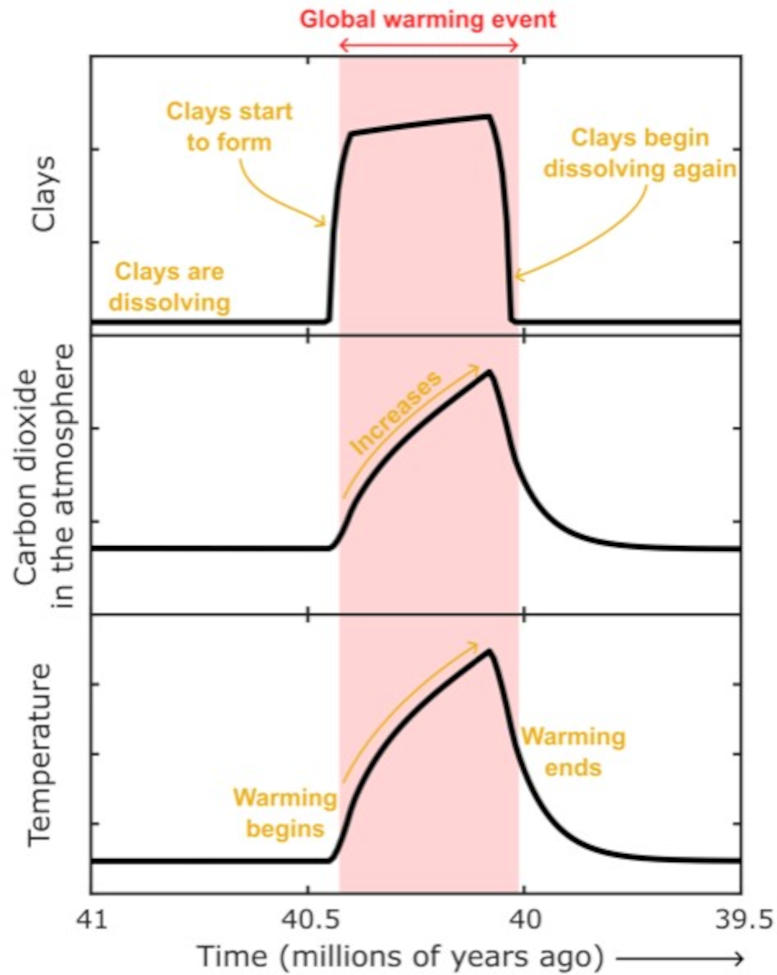
Past global warming events offer insights into natural mechanisms that regulated Earth’s climate, such as rock weathering, which reduced atmospheric carbon dioxide. Today, enhancing rock weathering could help mitigate climate change, but its effectiveness depends on local geological conditions and the potential for clay formation, which can inhibit the process.
Could blending of crushed rock with arable soil lower global temperatures? Mainz University scientists study global warming events from 40 and 56 million years ago to find answers.
The Earth is getting hotter, and the effects have been increasingly evident this summer across the globe. Looking back in geological history, events of global warming are not uncommon. Around 56 million years ago, during the Paleocene–Eocene Thermal Maximum (PETM), temperatures rose by an average of 5 to 8 degrees Celsius.
This increase in temperature was likely caused by heightened volcanic activity and the consequent release of vast amounts of carbon dioxide into the atmosphere. These elevated temperatures persisted for approximately 200,000 years.
Back in 2021, Professor Philip Pogge von Strandmann of Johannes Gutenberg University Mainz (JGU) had already investigated the effect that eventually led to global cooling and climatic recovery after the PETM warming.
In short: Rainwater combined with the atmospheric carbon dioxide, resulting in carbonic acid that caused enhanced weathering of rock, thus releasing calcium and magnesium. Rivers then transported the calcium, magnesium, and carbonic acid into the oceans where the calcium, magnesium – and also the carbon dioxide – came together to form insoluble limestone.
“In other words, there is a feedback effect that helps control the climate. High temperatures accelerate the chemical rock weathering process, reducing the levels of carbon dioxide in the atmosphere, allowing the climate to recover,” said Pogge von Strandmann.
Climate required twice as long to regenerate 40 million years ago
Climate warming occurred again 16 million years after the PETM during the Middle Eocene Climatic Optimum or MECO. Although volcanic activity resulted in the discharge of roughly the same amounts of carbon dioxide into the atmosphere as during the PETM, it took far longer for the climate to restabilize.
The warming effect lasted for an immense 400,000 years, twice as long as in the PETM. Why was recovery so slow during that period?

The graphs illustrate changes to climate, carbon dioxide concentrations, and clay formation during the MECO. Credit: Alexander Krause
In searching for an answer, Pogge von Strandmann and co-authors, including first author Alex Krause, began analyzing 40-million-year-old oceanic carbonates and clay minerals to compare the results with those for similar 56-million-year-old examples. “Just as during the PETM, there was also intensified weathering and erosion in the MECO.
However, there was far less exposed rock on the Earth’s surface 40 million years ago. Instead, the Earth was extensively covered by a global rainforest the soil of which largely consisted of clay minerals,” explained the researcher. In contrast with rock, clay does not weather; in fact, it is actually the product of weathering. “So despite the high temperatures, the widespread clay soil prevented rocks from being effectively weathered, a process known as soil shielding,” the geoscientist pointed out.
Enhanced weathering for climate protection
How can we use this knowledge in today’s world? “We study paleoclimates to determine whether and how we can positively influence our present climate. One option might be to boost the chemical weathering of rock. To help achieve this, we could plow finely crushed rock into our fields,” said Pogge von Strandmann.
The fine-grained particles of rock would erode rapidly, resulting in the binding of atmospheric carbon dioxide, thus enabling the climate to recuperate. Negative emissions technologies (NETs) such as this involving the absorption of carbon dioxide are the subjects of intense research across the globe. At the same time, however, if the weathering results in the formation of clay, the effects of the process would be significantly less efficient, as Pogge von Strandmann has discovered.
Clay retains the calcium and magnesium that would otherwise be delivered to the ocean. The carbon dioxide would continue to flow into the oceans, but it would not be bound there and would be able to escape back into the atmosphere. In this case, the weathering effect would have next to no influence on the climate.
If the rock particles fully dissolve as a result of weathering, the enhanced weathering concept would turn out to be 100 percent efficient. However, if all the weathered materials were turned into clay, this would in its turn completely nullify the effect.
In reality, the actual outcome would probably be somewhere between the two extremes: While there was enhanced erosion of rock in the PETM so that the climate normalized more rapidly, clay formation was predominant during the MECO. The extent to which the crushed rock dissolves and how much of it is preserved as clay depends on a range of local factors, such as the globally pre-existing levels of clay and rock. So in order to establish whether the process of enhanced weathering is a viable approach, it would first be necessary to find out how much clay is formed during the weathering process at each potential location.
Reference: “Enhanced clay formation key in sustaining the Middle Eocene Climatic Optimum” by Alexander J. Krause, Appy Sluijs, Robin van der Ploeg, Timothy M. Lenton and Philip A. E. Pogge von Strandmann, 31 July 2023, Nature Geoscience.
DOI: 10.1038/s41561-023-01234-y
Also involved in the project were researchers at University College London and the University of Essex in the UK as well as Utrecht University in the Netherlands.









“One option might be to boost the chemical weathering of rock. To help achieve this, we could plow finely crushed rock into our fields, …”
That “finely crushed rock” doesn’t come for free. Basalt quarries have to be blasted, the resulting boulders have to be broken up and hauled out of the quarry; it then has to be sent to crushers, screened, and then hauled to the fields, which is often the most expensive part, and then applied. All of these steps require energy, which is usually obtained from fossil fuels. So, in order to reduce CO2, we produce CO2. Somebody has to look at not only the dollar costs, but also the net gain.
This isn’t the first time I have seen someone propose using mafic or ultramafic rocks to sequester CO2. However, they all look at the theoretical sides, and not the practical and economic aspects.
Someone will probably suggest using so-called renewable power. Explosives can’t be made of electricity alone. The huge haulage trucks, with tires about 3 meters in diameter, have never been battery powered. It is questionable whether it is feasible. Quarries are rough on trucks, and the shocks may shorten the lives of batteries and make for spectacular, work-halting, fires.
Mr. Spencer is correct. What these scientists don’t seem to know is that almost all of the limestones at that time were made by invertebrate animals who were using vegetations that sequestered CO2 for energy. And when their shells were preserved as fossils their bodies were recycled back to CO2 and water. The same is true for algae, most of which do not form carbonates. And clay minerals are aluminosilicates that “sequester” potassium, iron, magnesium, little calcium or none at all…kaolin. There’s a bit more needed in this idea.